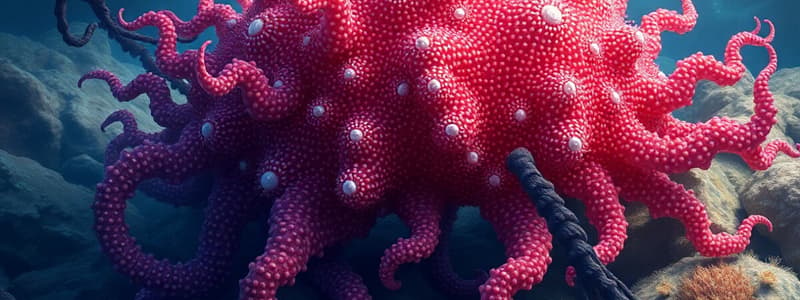Podcast
Questions and Answers
Invertebrates constitute ______ percent of known organisms in the animal kingdom.
Invertebrates constitute ______ percent of known organisms in the animal kingdom.
95
Porifera or sponges lack a ______.
Porifera or sponges lack a ______.
backbone
Most coelenterates are ______, meaning they live in saltwater.
Most coelenterates are ______, meaning they live in saltwater.
marine
Coelenterates have an opening in the center of their body surrounded by ______.
Coelenterates have an opening in the center of their body surrounded by ______.
Worms move by sliding or ______.
Worms move by sliding or ______.
Worms breathe through their ______.
Worms breathe through their ______.
Porifera obtain food from the water through their body's ______.
Porifera obtain food from the water through their body's ______.
Some coelenterates produce ______ to protect themselves from predators.
Some coelenterates produce ______ to protect themselves from predators.
Mollusks can reproduce sexually or ______.
Mollusks can reproduce sexually or ______.
Some mollusks, like the queen conch and garden snails, have a very hard external ______.
Some mollusks, like the queen conch and garden snails, have a very hard external ______.
Arthropods are distinguished by the presence of a ______, which protects them.
Arthropods are distinguished by the presence of a ______, which protects them.
Arthropods are classified into four subgroups: insects, arachnids, crustaceans, and ______.
Arthropods are classified into four subgroups: insects, arachnids, crustaceans, and ______.
Echinoderms, such as starfish, have a spiny surface and live in ______.
Echinoderms, such as starfish, have a spiny surface and live in ______.
The rigid surface of echinoderms derives from their unique structure, which is often referred to as spiny ______.
The rigid surface of echinoderms derives from their unique structure, which is often referred to as spiny ______.
Arthropods usually have ______ legs and two antennae on their heads.
Arthropods usually have ______ legs and two antennae on their heads.
Flashcards
Mollusks
Mollusks
Animals with soft bodies, often with shells (e.g., snails, squids).
Mollusks Reproduction
Mollusks Reproduction
Can reproduce sexually or asexually.
Arthropods
Arthropods
Animals with exoskeletons and jointed appendages (e.g., insects, spiders).
Echinoderms
Echinoderms
Signup and view all the flashcards
Arthropod subgroups
Arthropod subgroups
Signup and view all the flashcards
Echinoderms habitat
Echinoderms habitat
Signup and view all the flashcards
Arthropod locomotion
Arthropod locomotion
Signup and view all the flashcards
Invertebrates
Invertebrates
Signup and view all the flashcards
Porifera (Sponges)
Porifera (Sponges)
Signup and view all the flashcards
Coelenterates
Coelenterates
Signup and view all the flashcards
Worms (Invertebrates)
Worms (Invertebrates)
Signup and view all the flashcards
Aquatic Invertebrates
Aquatic Invertebrates
Signup and view all the flashcards
Invertebrate Groups
Invertebrate Groups
Signup and view all the flashcards
Invertebrate Abundance
Invertebrate Abundance
Signup and view all the flashcards
Worm Nutrition
Worm Nutrition
Signup and view all the flashcards
Study Notes
Invertebrates
- Invertebrates make up 95% of known organisms in the animal kingdom.
- They are multicellular and lack a backbone.
- They are divided into six groups: Porifera, Coelenterates, Worms, Mollusks, Arthropods, and Echinoderms.
Porifera (Sponges)
- Unusual organisms resembling plants.
- Simple body structure; no tissues or organs, brain, head, blood, or muscles.
- Vary in color, size, and shape.
- Can live a long time, with few predators.
- Some produce toxins for protection.
- Aquatic; some freshwater, others saltwater.
- Young sponges are mobile larvae.
- Adults remain stationary.
- Absorb water and oxygen through pores, and release waste.
Coelenterates (e.g., sea anemone, fan coral)
- Aquatic invertebrates, mostly marine.
- Have a central opening for feeding surrounded by tentacles.
- Simple nervous system.
- Reproduce sexually or asexually.
- Many produce toxins for protection, which can be harmful to humans.
- Examples include jellyfish, sea anemones, and corals.
Worms
- Invertebrate animals with long, soft bodies.
- Some have ring-like divisions.
- Lack limbs; move by sliding or contracting.
- Abundant in various environments (underground, water, humid places).
- Lack lungs; breathe through their skin.
- Predators include birds and salamanders.
- Important role in soil health; eat and decompose organic matter (plants, dead animals, bacteria, fungi).
- Reproduce sexually or asexually.
Mollusks (e.g., slugs, squid)
- Soft-bodied animals, some with hard shells for protection.
- Can live on land and in the sea.
- Some have one shell (e.g., queen conch, garden snails), others have two shells (e.g., clams).
- Some have no shell (e.g., slugs).
Arthropods
- Make up around 75% of animals.
- Characterized by an exoskeleton.
- Bodies divided into segments.
- Legs and appendages with joints.
- Cold-blooded.
- Can live in water, on land, or fly.
- Good eyesight and hearing.
- Use antennae for sensing.
- Four subgroups: insects, arachnids, crustaceans, and myriapods.
Insects (e.g., wasps, beetles, ants, butterflies)
- Typically have six legs, two antennae, and eyes on each side of their heads.
- Some insects produce toxins (e.g., bees).
Arachnids (e.g., scorpions, spiders, ticks)
- Eight legs.
- No antennae.
- Bodies divided into cephalothorax and abdomen.
- Venomous in some species.
Crustaceans (e.g., lobsters, shrimp, crabs)
- Mostly aquatic.
- Bodies divided into cephalothorax and abdomen.
- Strong shell.
- Two antennae and typically have 10 legs, with some having functional pincers.
Myriapods (e.g., centipedes, millipedes)
- Many legs; each body segment with two legs.
- Two antennae.
- Some are venomous.
Echinoderms (e.g., starfish, sea lilies, sea urchins)
- Star or round shape, lack a head.
- Have feet for movement on sea floors.
- Internal skeleton of calcareous plates (e.g., spikes).
- Reproduce sexually, with larval stage.
- Live in water.
- Have around 7000 species.
- Lack heart and blood.
- Move with arms.
Studying That Suits You
Use AI to generate personalized quizzes and flashcards to suit your learning preferences.



